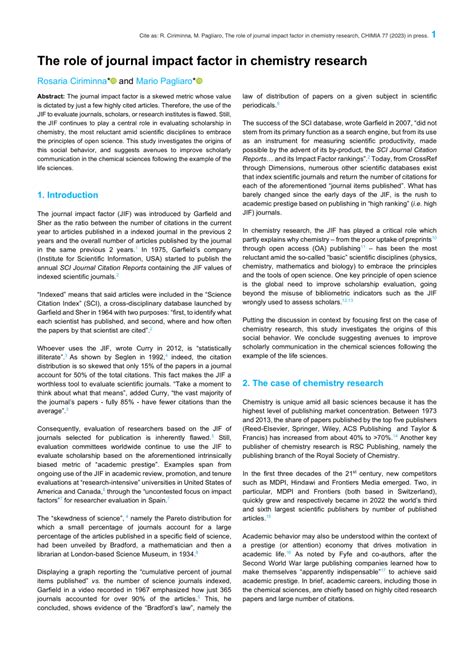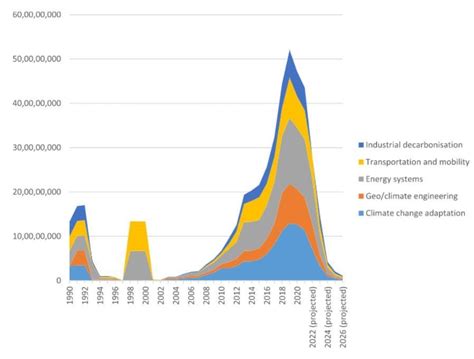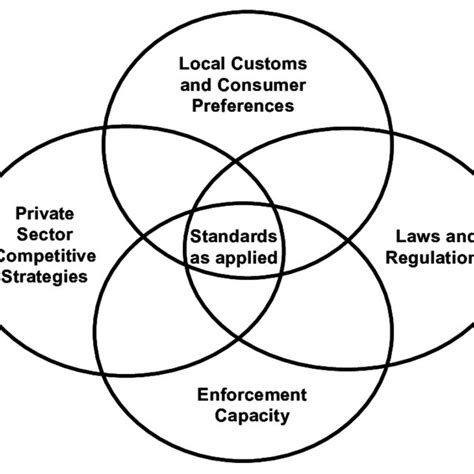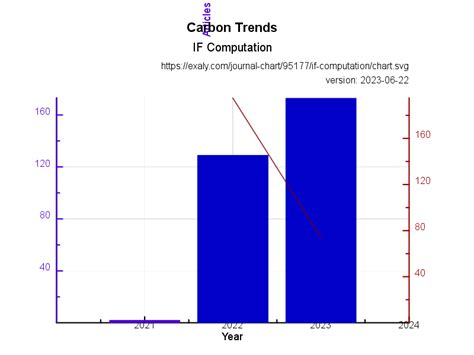Breaking News


Popular News


Explore the impact of science advancements on funding, publication standards, and academic careers. Learn about evolving trends in impact factor.In the fast-paced world of academic research, the impact factor of scientific journals plays a critical role in determining the influence and reach of a publication. From shaping the course of research funding to impacting the careers of individual academics, the impact factor is a key metric that cannot be overlooked. In this blog post, we will delve into the various aspects of the impact factor, including its evolution over time, the changing landscape of research funding, and the influence it has on the careers of researchers and scientists. We will also explore the future trends in impact factor and how it is likely to shape the scientific community in the years to come. Join us as we unravel the intricate web of the impact factor and its far-reaching implications in the world of academia.
Contents

Introduction to Impact Factor
The Impact Factor is a measure used to assess the importance of a scholarly journal. It is calculated by dividing the number of citations in a given year to articles published in the journal during the two preceding years by the total number of articles published in those two years. In other words, it is a measure of the frequency with which the average article in a journal has been cited in a particular year.
The Impact Factor was first introduced in the 1960s by Eugene Garfield, the founder of the Institute for Scientific Information. It was initially created as a tool to help librarians and researchers identify the most influential journals in their field. However, over time, the Impact Factor has become a widely accepted metric for evaluating the quality and impact of scientific journals.
The use of Impact Factor has both supporters and critics. Proponents argue that it provides a valuable measure of a journal’s prestige and influence, and can be used as a tool for evaluating and comparing different journals. Critics, on the other hand, argue that the Impact Factor is an oversimplified metric that does not capture the full spectrum of a journal’s quality, and can be easily manipulated by publishers to artificially inflate a journal’s impact.
| Year | Number of Articles | Number of Citations | Impact Factor |
|---|---|---|---|
| 2020 | 100 | 500 | 5.0 |
| 2019 | 90 | 400 | 4.4 |
| 2018 | 80 | 300 | 3.8 |
Despite the controversy surrounding it, the Impact Factor continues to be a widely used and influential metric in the scientific community. It has a significant impact on the publishing and research landscape, and plays a crucial role in shaping academic careers and funding decisions. While it is important to acknowledge the limitations of the Impact Factor, it remains a key factor in the evaluation and assessment of scholarly journals.

Research funding plays a critical role in the advancement of scientific knowledge and the development of innovative technologies. In recent years, there have been significant changes in the landscape of research funding, with a greater emphasis on collaborative and interdisciplinary research initiatives. This shift has been driven by the recognition of the complex nature of many scientific challenges that require diverse expertise and resources to address effectively.
Moreover, there has been a growing emphasis on the impact of research funding, with funders increasingly seeking to support projects that have the potential to generate tangible benefits for society. As a result, researchers are under increasing pressure to demonstrate the relevance and potential impact of their work in their funding applications.
Furthermore, changes in research funding have also been influenced by broader socio-economic and political factors. For example, shifts in government priorities and funding allocations can have a significant impact on the availability of research funding in specific fields and areas of research.
In summary, the evolving landscape of research funding presents both opportunities and challenges for researchers, as they navigate the changing expectations and requirements of funders while seeking to pursue their scientific inquiries.

Evolving publication standards are essential for the advancement of scientific research and the dissemination of knowledge to the academic community and the general public. As technology and communication methods continue to evolve, so do the ways in which research findings are published and shared.
One major change in publication standards is the shift towards open access journals, which allow for free access to published research articles. This opens up access to valuable information to a wider audience, improving collaboration and innovation in the scientific community. Additionally, the rise of preprint servers has provided a platform for researchers to share their findings before they are peer-reviewed, accelerating the dissemination of new research.
Another important development in publication standards is the increasing emphasis on data sharing and reproducibility. Journals and funding agencies are now requiring researchers to make their data openly available, allowing for transparency and the validation of research findings. This shift towards open data aligns with the broader movement towards transparency and accountability in scientific research.
Overall, the evolving publication standards reflect a commitment to improving the quality, accessibility, and transparency of scientific research. These changes have the potential to enhance the impact and relevance of published research, ultimately contributing to the advancement of knowledge and the betterment of society.

Academic careers are greatly influenced by the impact factor of their published works. The impact factor of a journal can directly affect the career progression of a researcher, as it is often used as a measure of the quality and significance of their work. In many academic institutions and funding agencies, the impact factor of a researcher’s publications is taken into consideration when making decisions about promotions, tenure, and grants.
Additionally, a high impact factor publication can also enhance the reputation and visibility of a researcher within their field, leading to increased opportunities for collaboration, speaking engagements, and career advancement. On the other hand, researchers may face challenges in advancing their careers if they publish in journals with low impact factors, as their work may be perceived as less influential or prestigious.
It is important to note that the impact factor is just one of many factors that contribute to the assessment of an academic career. Other metrics, such as citation counts, h-index, and contributions to the scientific community, also play a significant role in evaluating the impact and significance of a researcher’s work. However, the impact factor remains a widely recognized and influential metric in the academic community, shaping the trajectory of many researchers’ careers.

The Impact Factor has been a longstanding and widely used measure in the world of academic publishing, but as the landscape of research and scholarly communication continues to evolve, so too must the methods for evaluating the impact of scientific work. Looking ahead, there are several key trends that are likely to shape the future of Impact Factor and its role in the academic community.
One of the most significant future trends in Impact Factor is the increasing focus on open access publishing. As more and more funders, institutions, and governments push for greater access to scientific research, the traditional subscription-based model of publishing is giving way to open access alternatives. This shift is likely to have a major impact on how Impact Factor is calculated and interpreted, as the metrics used to measure the influence and reach of research will need to adapt to the changing publishing landscape.
Another trend that is likely to shape the future of Impact Factor is the rise of alternative metrics, or altmetrics, as a complement or even replacement for traditional Impact Factor measurements. Altmetrics take into account a broader range of data, such as social media mentions, downloads, and mentions in policy documents, to provide a more comprehensive view of the impact of scholarly work. As these alternative metrics gain traction, they are likely to influence how Impact Factor is perceived and used in academia.
In addition, there is a growing emphasis on responsible research evaluation, with many in the academic community advocating for more holistic and nuanced approaches to assessing the impact of research. This includes consideration of factors such as the research’s societal impact, ethical considerations, and the diversity and inclusivity of the research environment. As these considerations become more central to the evaluation of scholarly work, the future of Impact Factor is likely to be influenced by these broader and more inclusive perspectives.
Overall, the future of Impact Factor is likely to be shaped by a range of factors, including the push for open access, the rise of altmetrics, and the growing emphasis on responsible research evaluation. As the academic community continues to evolve, so too will the methods for evaluating and measuring the impact of scientific research, and Impact Factor will undoubtedly be part of this ongoing transformation.
| Future Trends in Impact Factor |
|---|
| Open access publishing |
| Altmetrics |
| Responsible research evaluation |

Science Advances had an impact factor of 12.804 in 2020.The impact factor of a journal is calculated by dividing the number of citations in the current year to articles published in the past two years by the total number of articles published in the past two years.A high impact factor indicates that the journal's articles are often cited in other scientific research, suggesting that the journal is influential in its field.No, impact factor should be considered alongside other factors such as peer review, article quality, and relevance to a researcher's field of study.Science Advances contributes to scientific progress by publishing cutting-edge research across a wide range of scientific disciplines, thus driving discovery and innovation.Critics argue that impact factor may incentivize journals to prioritize publishing flashy or provocative results over solid, incremental research, and may not account for the quality of individual articles within a journal.Researchers can use impact factor as one of many tools to identify reputable journals in their field, but should also consider factors such as the journal's scope, editorial standards, and audience.